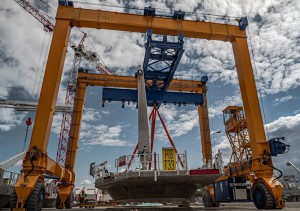
High-Tech Heavy Duty Semi Gantry Crane for Sale
Introduction
A semi-gantry crane is a type of overhead crane with a unique structure. One side of its legs is mounted on wheels or rails, allowing it to move freely, while the other side is supported by a runway system connected to the building columns or the side wall of the building structure. This design offers significant advantages in space utilization by effectively saving valuable floor and workspace. As a result, it is particularly well-suited for environments with limited space, such as indoor workshops. Semi-gantry cranes are versatile and can be used in various operational settings, including heavy fabrication applications and outdoor yards (such as rail yards, shipping/container yards, steel yards, and scrap yards).
Additionally, the design allows forklifts and other motorized vehicles to work and pass underneath the crane without obstruction.
Make an Informed Purchase Decision
-Before making a purchase decision, it is important to have a clear understanding of your workload, lifting height and other specific operational needs.
-With years of expertise, SEVENCRANE has a team of experts dedicated to helping you select the lifting solution that best meets your goals. Selecting the right girder form, lifting mechanism and components is essential. This not only ensures optimal operational efficiency, but also helps you effectively manage costs to stay within your budget.
-Ideal for light to medium-duty applications, semi-gantry cranes are a cost-effective solution that reduces material and transportation costs.
-However, it does have some limitations, including restrictions on workload, span and hook height. In addition, installing special features such as walkways and cabs can also pose challenges. However, this crane remains a practical and reliable choice for cost-effective operations that are not subject to these restrictions.
-If you are considering investing in a new semi-gantry crane system and require a detailed quote, or you are seeking expert advice on the best lifting solution for a specific operation, please feel free to contact us.




Customize Your Semi Gantry Crane
Of course, we also offer a customized service.To provide you with the most accurate and tailored design solution, please share the following details:
1.Lifting Capacity:
Please specify the maximum weight your crane needs to lift. This critical information enables us to design a system that can handle your loads safely and efficiently.
2.Span Length (Rail Center to Rail Center):
Provide the distance between the centers of the rails. This measurement directly impacts the overall structure and stability of the crane we’ll design for you.
3.Lifting Height (Hook Center to Ground):
Indicate how high the hook needs to reach from the ground level. This helps determine the appropriate mast or girder height for your lifting operations.
4. Rail Installation:
Have you already installed the rails?If not, would you like us to supply them?Additionally, please specify the required rail length. This information helps us plan the complete setup for your crane system.
5. Power Supply:
Specify the voltage of your power source.Different voltage requirements affect the electrical components and wiring design of the crane.
6. Working Conditions:
Describe the types of materials you’ll be lifting and the ambient temperature. These factors influence the choice of materials, coatings, and mechanical properties for the crane to ensure its durability and optimal performance.
7. Workshop Drawing/Photo:
If possible, sharing a drawing or photo of your workshop would be highly beneficial. This visual information helps our team better understand your space, layout, and any potential obstacles, allowing us to tailor the crane design more precisely to your site.
















